2007 ISUZU KB P190 fuse
[x] Cancel search: fusePage 1099 of 6020
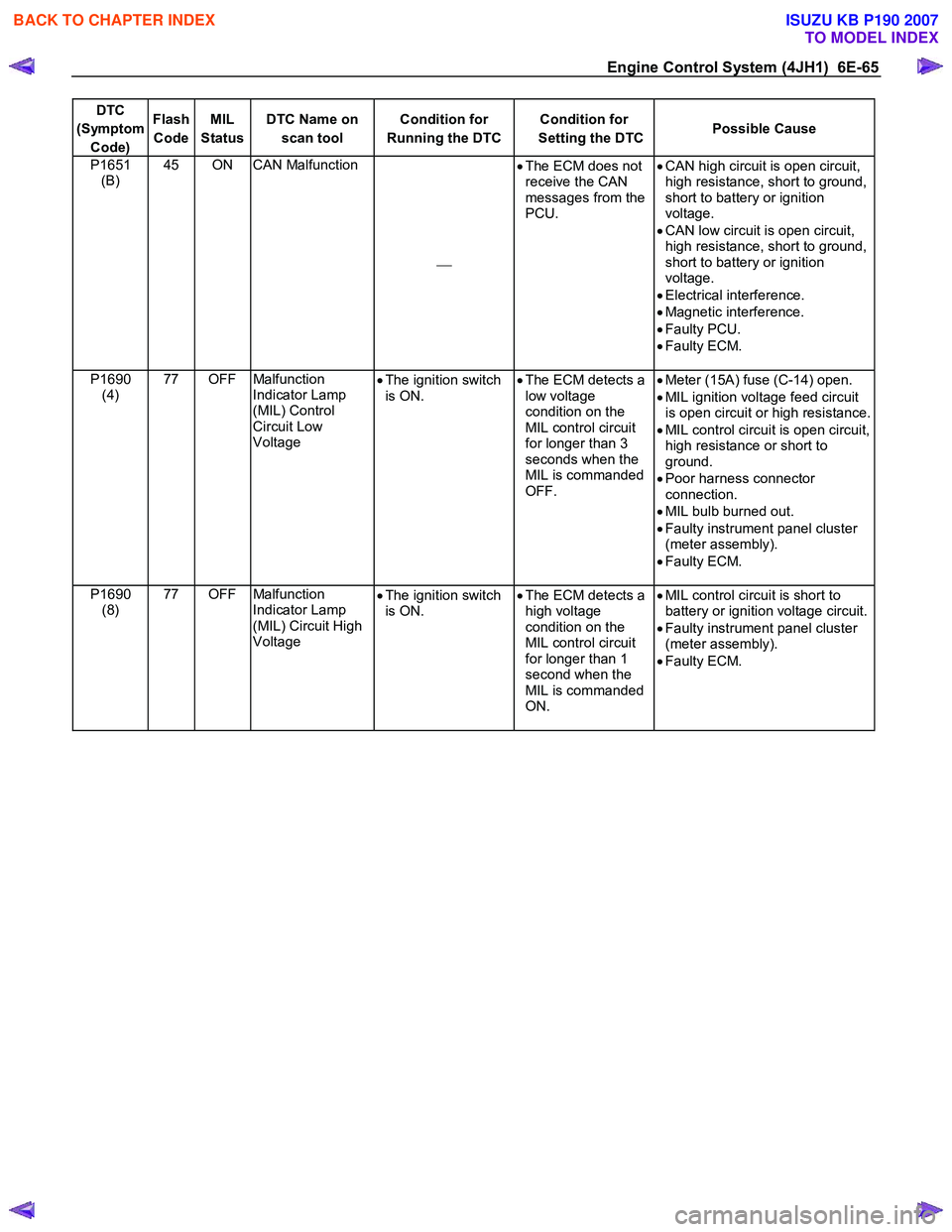
Engine Control System (4JH1) 6E-65
DTC
(Symptom Code) Flash
Code MIL
Status DTC Name on
scan tool Condition for
Running the DTC Condition for
Setting the DTC Possible Cause
P1651
(B) 45 ON CAN Malfunction
•
The ECM does not
receive the CAN
messages from the
PCU.
•
CAN high circuit is open circuit,
high resistance, short to ground,
short to battery or ignition
voltage.
• CAN low circuit is open circuit,
high resistance, short to ground,
short to battery or ignition
voltage.
• Electrical interference.
• Magnetic interference.
• Faulty PCU.
• Faulty ECM.
P1690 (4) 77 OFF Malfunction
Indicator Lamp
(MIL) Control
Circuit Low
Voltage •
The ignition switch
is ON. •
The ECM detects a
low voltage
condition on the
MIL control circuit
for longer than 3
seconds when the
MIL is commanded
OFF.
•
Meter (15A) fuse (C-14) open.
• MIL ignition voltage feed circuit
is open circuit or high resistance.
• MIL control circuit is open circuit,
high resistance or short to
ground.
• Poor harness connector
connection.
• MIL bulb burned out.
• Faulty instrument panel cluster
(meter assembly).
• Faulty ECM.
P1690 (8) 77 OFF Malfunction
Indicator Lamp
(MIL) Circuit High
Voltage •
The ignition switch
is ON. •
The ECM detects a
high voltage
condition on the
MIL control circuit
for longer than 1
second when the
MIL is commanded
ON.
•
MIL control circuit is short to
battery or ignition voltage circuit.
• Faulty instrument panel cluster
(meter assembly).
• Faulty ECM.
BACK TO CHAPTER INDEX
TO MODEL INDEX
ISUZU KB P190 2007
Page 1104 of 6020
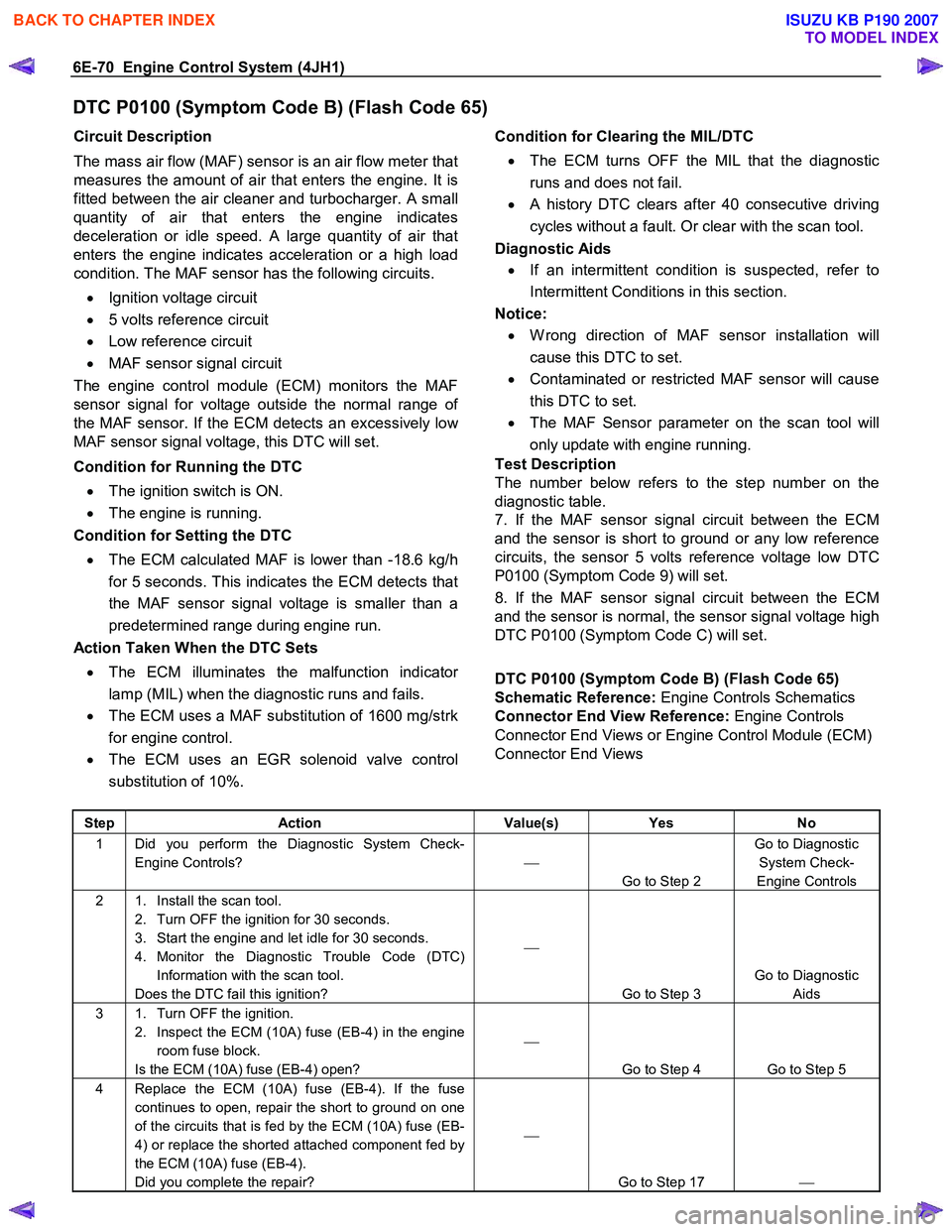
6E-70 Engine Control System (4JH1)
DTC P0100 (Symptom Code B) (Flash Code 65)
Circuit Description
The mass air flow (MAF) sensor is an air flow meter that
measures the amount of air that enters the engine. It is
fitted between the air cleaner and turbocharger. A small
quantity of air that enters the engine indicates
deceleration or idle speed. A large quantity of air that
enters the engine indicates acceleration or a high load
condition. The MAF sensor has the following circuits.
• Ignition voltage circuit
• 5 volts reference circuit
• Low reference circuit
• MAF sensor signal circuit
The engine control module (ECM) monitors the MAF
sensor signal for voltage outside the normal range o
f
the MAF sensor. If the ECM detects an excessively low
MAF sensor signal voltage, this DTC will set.
Condition for Running the DTC
• The ignition switch is ON.
• The engine is running.
Condition for Setting the DTC
• The ECM calculated MAF is lower than -18.6 kg/h
for 5 seconds. This indicates the ECM detects that
the MAF sensor signal voltage is smaller than a
predetermined range during engine run.
Action Taken When the DTC Sets
• The ECM illuminates the malfunction indicato
r
lamp (MIL) when the diagnostic runs and fails.
• The ECM uses a MAF substitution of 1600 mg/strk
for engine control.
• The ECM uses an EGR solenoid valve control
substitution of 10%.
Condition for Clearing the MIL/DTC
• The ECM turns OFF the MIL that the diagnostic
runs and does not fail.
• A history DTC clears after 40 consecutive driving
cycles without a fault. Or clear with the scan tool.
Diagnostic Aids
• If an intermittent condition is suspected, refer to
Intermittent Conditions in this section.
Notice: • W rong direction of MAF sensor installation will
cause this DTC to set.
• Contaminated or restricted MAF sensor will cause
this DTC to set.
• The MAF Sensor parameter on the scan tool will
only update with engine running.
Test Description
The number below refers to the step number on the
diagnostic table.
7. If the MAF sensor signal circuit between the ECM
and the sensor is short to ground or any low reference
circuits, the sensor 5 volts reference voltage low DTC
P0100 (Symptom Code 9) will set.
8. If the MAF sensor signal circuit between the ECM
and the sensor is normal, the sensor signal voltage high
DTC P0100 (Symptom Code C) will set.
DTC P0100 (Symptom Code B) (Flash Code 65)
Schematic Reference: Engine Controls Schematics
Connector End View Reference: Engine Controls
Connector End Views or Engine Control Module (ECM)
Connector End Views
Step Action Value(s) Yes No
1 Did you perform the Diagnostic System Check-
Engine Controls?
Go to Step 2 Go to Diagnostic
System Check-
Engine Controls
2 1. Install the scan tool. 2. Turn OFF the ignition for 30 seconds.
3. Start the engine and let idle for 30 seconds.
4. Monitor the Diagnostic Trouble Code (DTC) Information with the scan tool.
Does the DTC fail this ignition?
Go to Step 3 Go to Diagnostic
Aids
3 1. Turn OFF the ignition. 2. Inspect the ECM (10A) fuse (EB-4) in the engine room fuse block.
Is the ECM (10A) fuse (EB-4) open?
Go to Step 4 Go to Step 5
4 Replace the ECM (10A) fuse (EB-4). If the fuse continues to open, repair the short to ground on one
of the circuits that is fed by the ECM (10A) fuse (EB-
4) or replace the shorted attached component fed by
the ECM (10A) fuse (EB-4).
Did you complete the repair?
Go to Step 17
BACK TO CHAPTER INDEX
TO MODEL INDEX
ISUZU KB P190 2007
Page 1105 of 6020
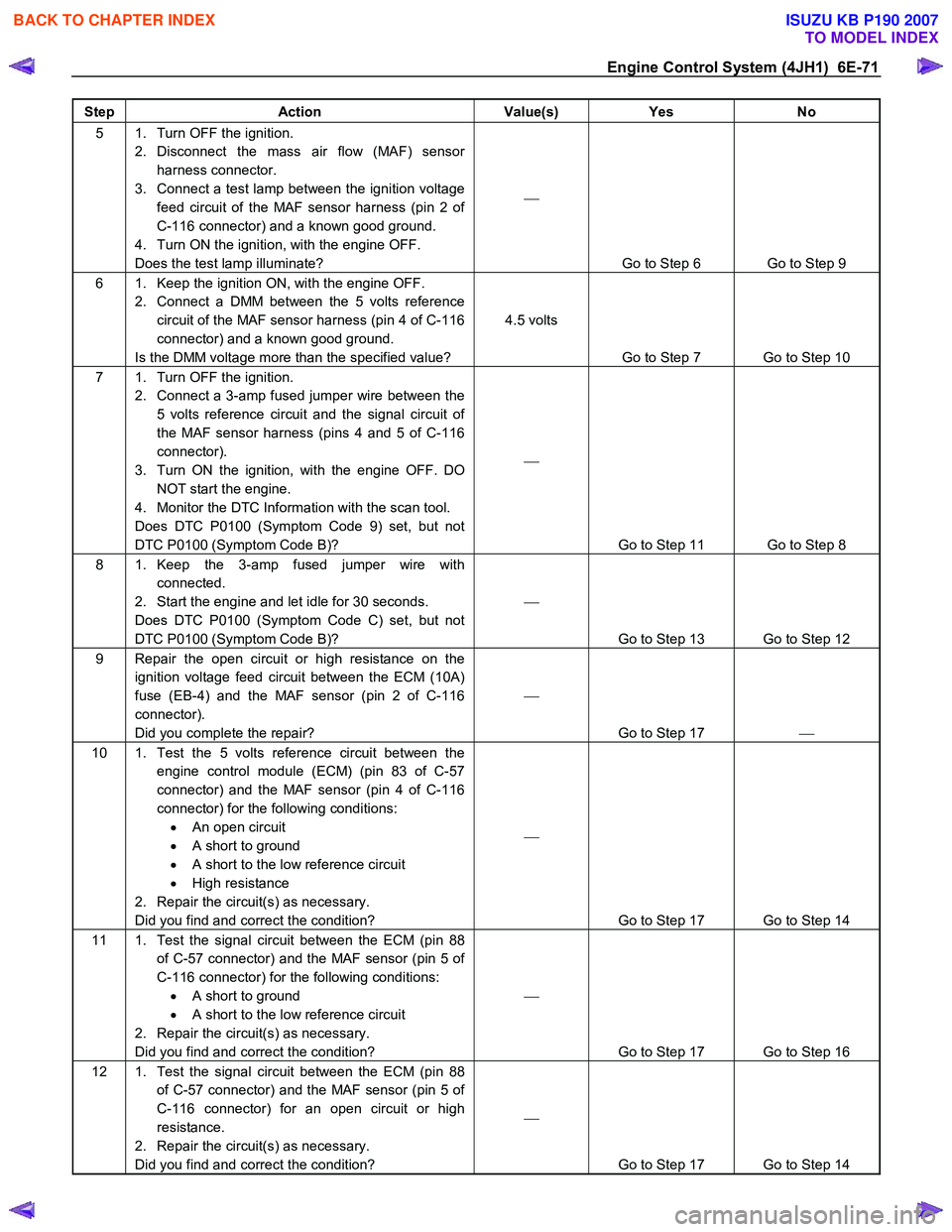
Engine Control System (4JH1) 6E-71
Step Action Value(s) Yes No
5 1. Turn OFF the ignition.
2. Disconnect the mass air flow (MAF) sensor harness connector.
3. Connect a test lamp between the ignition voltage feed circuit of the MAF sensor harness (pin 2 of
C-116 connector) and a known good ground.
4. Turn ON the ignition, with the engine OFF.
Does the test lamp illuminate?
Go to Step 6 Go to Step 9
6 1. Keep the ignition ON, with the engine OFF. 2. Connect a DMM between the 5 volts reference circuit of the MAF sensor harness (pin 4 of C-116
connector) and a known good ground.
Is the DMM voltage more than the specified value? 4.5 volts
Go to Step 7 Go to Step 10
7 1. Turn OFF the ignition. 2. Connect a 3-amp fused jumper wire between the 5 volts reference circuit and the signal circuit of
the MAF sensor harness (pins 4 and 5 of C-116
connector).
3. Turn ON the ignition, with the engine OFF. DO NOT start the engine.
4. Monitor the DTC Information with the scan tool.
Does DTC P0100 (Symptom Code 9) set, but not
DTC P0100 (Symptom Code B)?
Go to Step 11 Go to Step 8
8 1. Keep the 3-amp fused jumper wire with connected.
2. Start the engine and let idle for 30 seconds.
Does DTC P0100 (Symptom Code C) set, but not
DTC P0100 (Symptom Code B)?
Go to Step 13 Go to Step 12
9 Repair the open circuit or high resistance on the ignition voltage feed circuit between the ECM (10A)
fuse (EB-4) and the MAF sensor (pin 2 of C-116
connector).
Did you complete the repair?
Go to Step 17
10 1. Test the 5 volts reference circuit between the
engine control module (ECM) (pin 83 of C-57
connector) and the MAF sensor (pin 4 of C-116
connector) for the following conditions: • An open circuit
• A short to ground
• A short to the low reference circuit
• High resistance
2. Repair the circuit(s) as necessary.
Did you find and correct the condition?
Go to Step 17 Go to Step 14
11 1. Test the signal circuit between the ECM (pin 88 of C-57 connector) and the MAF sensor (pin 5 of
C-116 connector) for the following conditions: • A short to ground
• A short to the low reference circuit
2. Repair the circuit(s) as necessary.
Did you find and correct the condition?
Go to Step 17 Go to Step 16
12 1. Test the signal circuit between the ECM (pin 88 of C-57 connector) and the MAF sensor (pin 5 of
C-116 connector) for an open circuit or high
resistance.
2. Repair the circuit(s) as necessary.
Did you find and correct the condition?
Go to Step 17 Go to Step 14
BACK TO CHAPTER INDEX
TO MODEL INDEX
ISUZU KB P190 2007
Page 1106 of 6020
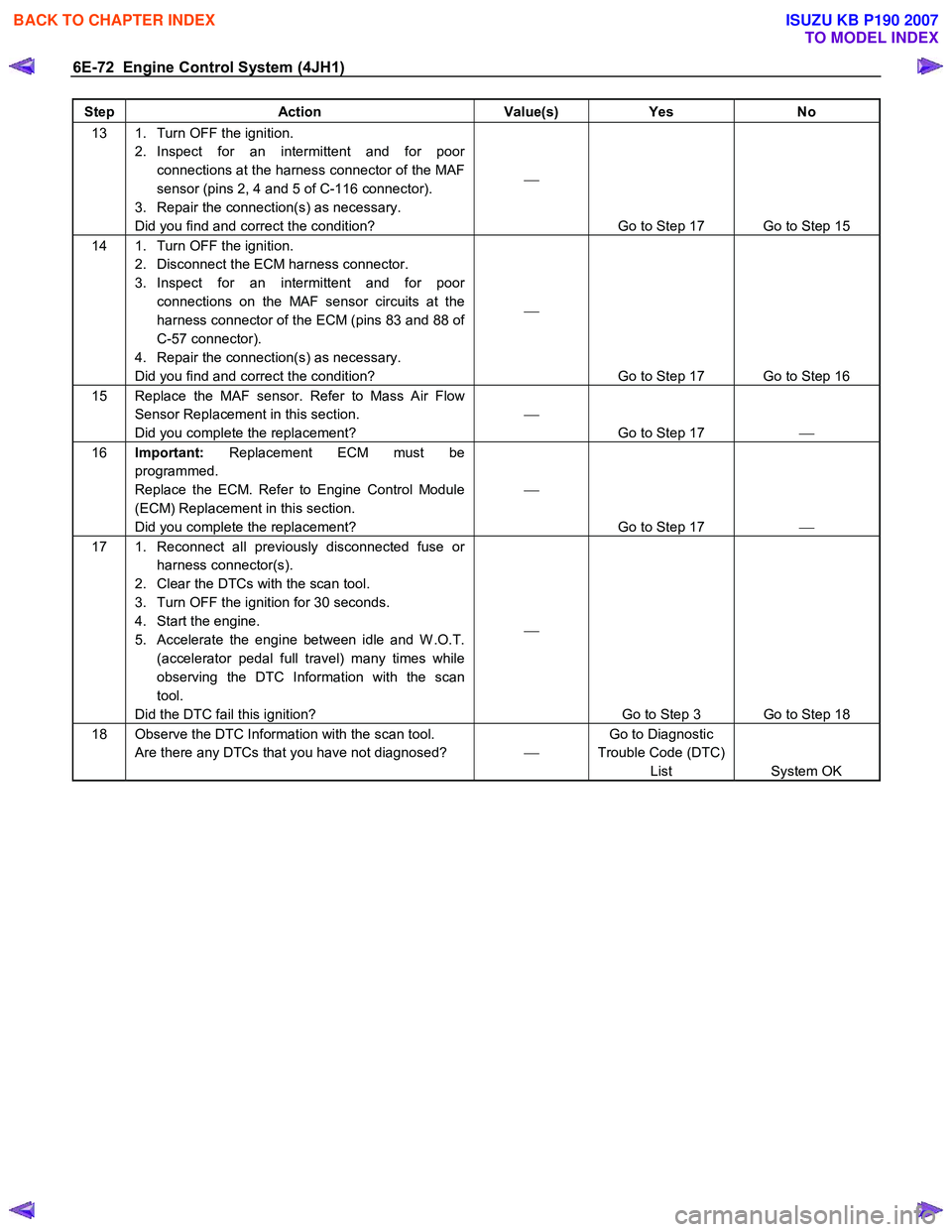
6E-72 Engine Control System (4JH1)
Step Action Value(s) Yes No
13 1. Turn OFF the ignition.
2. Inspect for an intermittent and for poor connections at the harness connector of the MAF
sensor (pins 2, 4 and 5 of C-116 connector).
3. Repair the connection(s) as necessary.
Did you find and correct the condition?
Go to Step 17 Go to Step 15
14 1. Turn OFF the ignition. 2. Disconnect the ECM harness connector.
3. Inspect for an intermittent and for poor connections on the MAF sensor circuits at the
harness connector of the ECM (pins 83 and 88 of
C-57 connector).
4. Repair the connection(s) as necessary.
Did you find and correct the condition?
Go to Step 17 Go to Step 16
15 Replace the MAF sensor. Refer to Mass Air Flow Sensor Replacement in this section.
Did you complete the replacement?
Go to Step 17
16 Important: Replacement ECM must be
programmed.
Replace the ECM. Refer to Engine Control Module
(ECM) Replacement in this section.
Did you complete the replacement?
Go to Step 17
17 1. Reconnect all previously disconnected fuse or
harness connector(s).
2. Clear the DTCs with the scan tool.
3. Turn OFF the ignition for 30 seconds.
4. Start the engine.
5. Accelerate the engine between idle and W .O.T. (accelerator pedal full travel) many times while
observing the DTC Information with the scan
tool.
Did the DTC fail this ignition?
Go to Step 3 Go to Step 18
18 Observe the DTC Information with the scan tool. Are there any DTCs that you have not diagnosed? Go to Diagnostic
Trouble Code (DTC) List System OK
BACK TO CHAPTER INDEX
TO MODEL INDEX
ISUZU KB P190 2007
Page 1113 of 6020
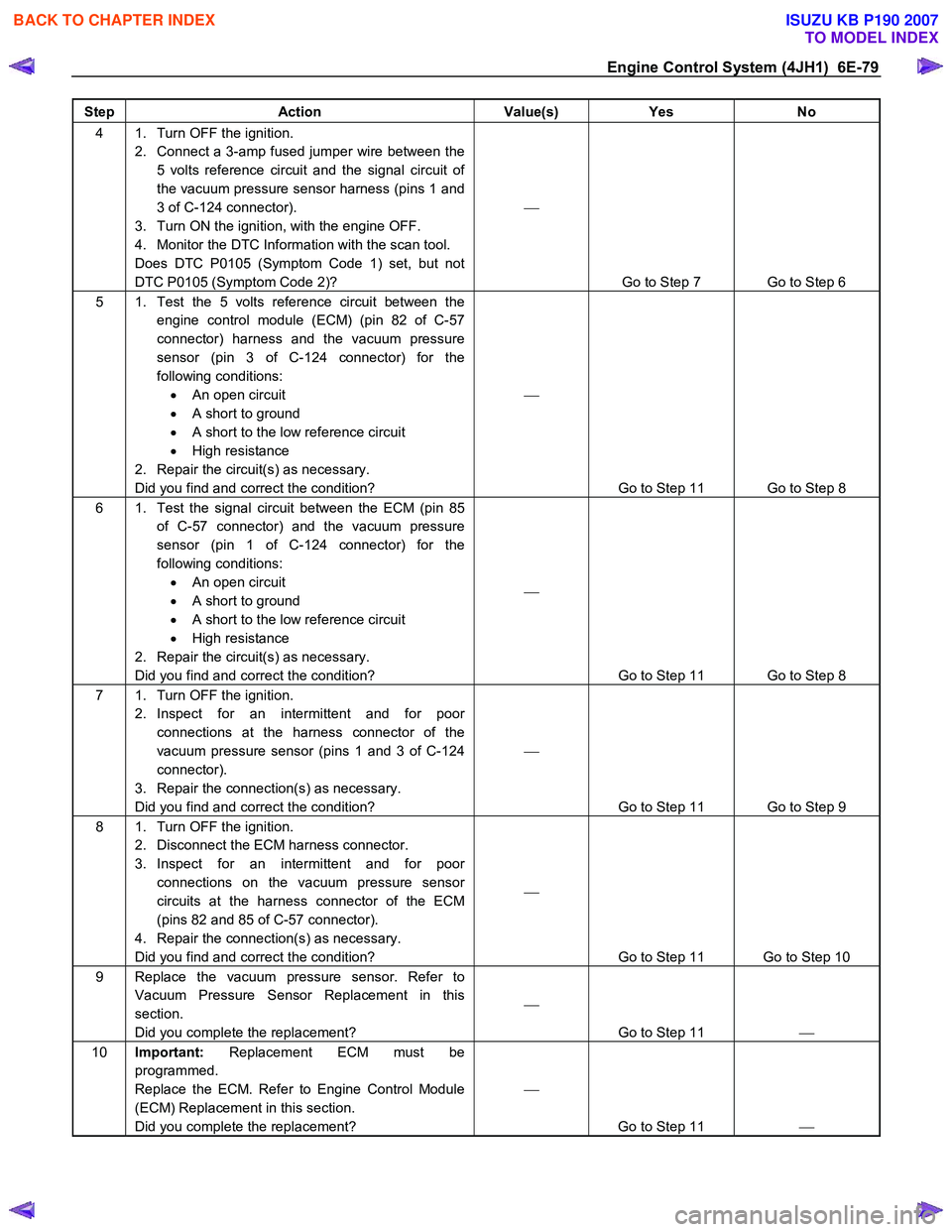
Engine Control System (4JH1) 6E-79
Step Action Value(s) Yes No
4 1. Turn OFF the ignition.
2. Connect a 3-amp fused jumper wire between the 5 volts reference circuit and the signal circuit of
the vacuum pressure sensor harness (pins 1 and
3 of C-124 connector).
3. Turn ON the ignition, with the engine OFF.
4. Monitor the DTC Information with the scan tool.
Does DTC P0105 (Symptom Code 1) set, but not
DTC P0105 (Symptom Code 2)?
Go to Step 7 Go to Step 6
5 1. Test the 5 volts reference circuit between the engine control module (ECM) (pin 82 of C-57
connector) harness and the vacuum pressure
sensor (pin 3 of C-124 connector) for the
following conditions: • An open circuit
• A short to ground
• A short to the low reference circuit
• High resistance
2. Repair the circuit(s) as necessary.
Did you find and correct the condition?
Go to Step 11 Go to Step 8
6 1. Test the signal circuit between the ECM (pin 85 of C-57 connector) and the vacuum pressure
sensor (pin 1 of C-124 connector) for the
following conditions: • An open circuit
• A short to ground
• A short to the low reference circuit
• High resistance
2. Repair the circuit(s) as necessary.
Did you find and correct the condition?
Go to Step 11 Go to Step 8
7 1. Turn OFF the ignition. 2. Inspect for an intermittent and for poor connections at the harness connector of the
vacuum pressure sensor (pins 1 and 3 of C-124
connector).
3. Repair the connection(s) as necessary.
Did you find and correct the condition?
Go to Step 11 Go to Step 9
8 1. Turn OFF the ignition. 2. Disconnect the ECM harness connector.
3. Inspect for an intermittent and for poor connections on the vacuum pressure sensor
circuits at the harness connector of the ECM
(pins 82 and 85 of C-57 connector).
4. Repair the connection(s) as necessary.
Did you find and correct the condition?
Go to Step 11 Go to Step 10
9 Replace the vacuum pressure sensor. Refer to Vacuum Pressure Sensor Replacement in this
section.
Did you complete the replacement?
Go to Step 11
10 Important: Replacement ECM must be
programmed.
Replace the ECM. Refer to Engine Control Module
(ECM) Replacement in this section.
Did you complete the replacement?
Go to Step 11
BACK TO CHAPTER INDEX
TO MODEL INDEX
ISUZU KB P190 2007
Page 1120 of 6020
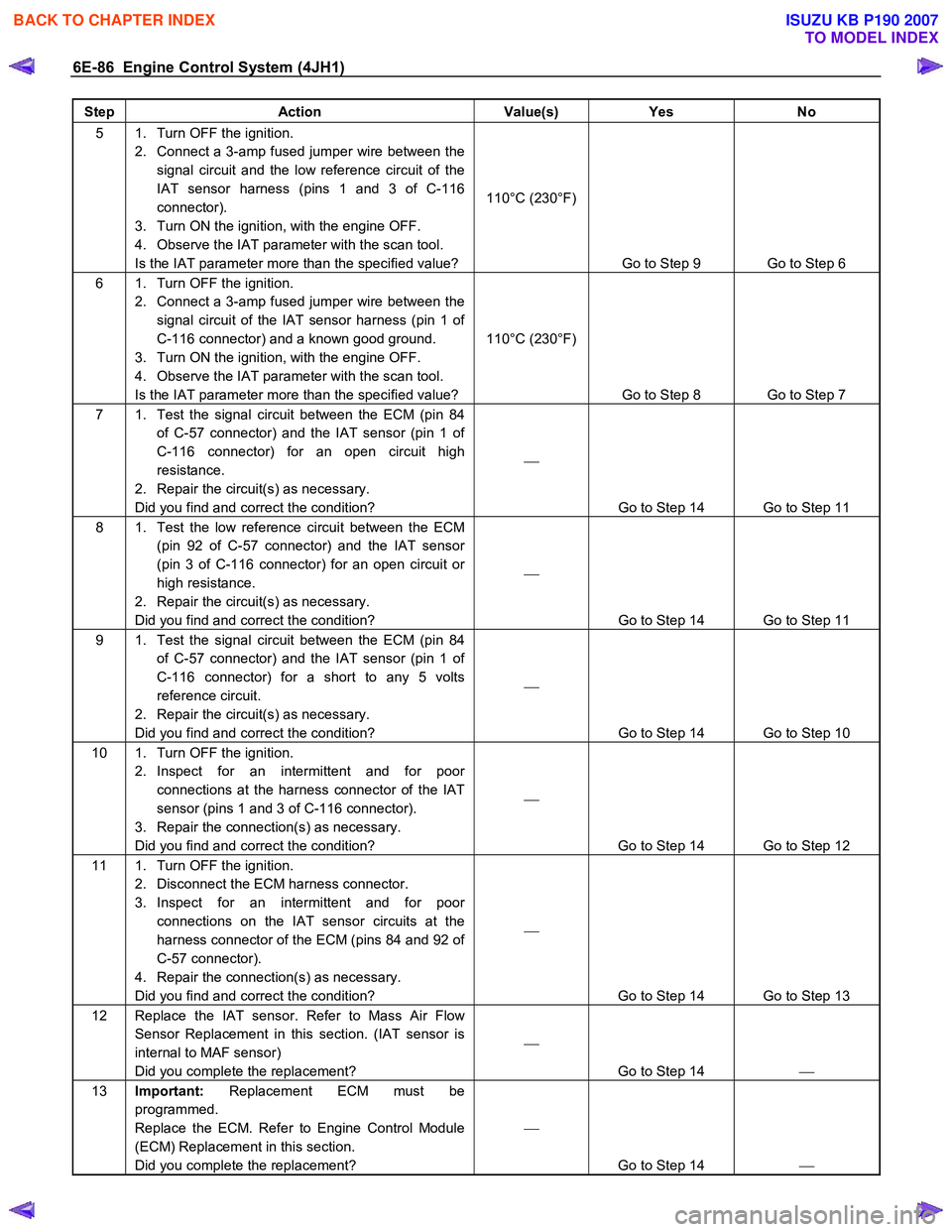
6E-86 Engine Control System (4JH1)
Step Action Value(s) Yes No
5 1. Turn OFF the ignition.
2. Connect a 3-amp fused jumper wire between the signal circuit and the low reference circuit of the
IAT sensor harness (pins 1 and 3 of C-116
connector).
3. Turn ON the ignition, with the engine OFF.
4. Observe the IAT parameter with the scan tool.
Is the IAT parameter more than the specified value? 110°C (230°F)
Go to Step 9 Go to Step 6
6 1. Turn OFF the ignition. 2. Connect a 3-amp fused jumper wire between the signal circuit of the IAT sensor harness (pin 1 of
C-116 connector) and a known good ground.
3. Turn ON the ignition, with the engine OFF.
4. Observe the IAT parameter with the scan tool.
Is the IAT parameter more than the specified value? 110°C (230°F)
Go to Step 8 Go to Step 7
7 1. Test the signal circuit between the ECM (pin 84 of C-57 connector) and the IAT sensor (pin 1 of
C-116 connector) for an open circuit high
resistance.
2. Repair the circuit(s) as necessary.
Did you find and correct the condition?
Go to Step 14 Go to Step 11
8 1. Test the low reference circuit between the ECM (pin 92 of C-57 connector) and the IAT sensor
(pin 3 of C-116 connector) for an open circuit or
high resistance.
2. Repair the circuit(s) as necessary.
Did you find and correct the condition?
Go to Step 14 Go to Step 11
9 1. Test the signal circuit between the ECM (pin 84 of C-57 connector) and the IAT sensor (pin 1 of
C-116 connector) for a short to any 5 volts
reference circuit.
2. Repair the circuit(s) as necessary.
Did you find and correct the condition?
Go to Step 14 Go to Step 10
10 1. Turn OFF the ignition. 2. Inspect for an intermittent and for poor connections at the harness connector of the IAT
sensor (pins 1 and 3 of C-116 connector).
3. Repair the connection(s) as necessary.
Did you find and correct the condition?
Go to Step 14 Go to Step 12
11 1. Turn OFF the ignition. 2. Disconnect the ECM harness connector.
3. Inspect for an intermittent and for poor connections on the IAT sensor circuits at the
harness connector of the ECM (pins 84 and 92 of
C-57 connector).
4. Repair the connection(s) as necessary.
Did you find and correct the condition?
Go to Step 14 Go to Step 13
12 Replace the IAT sensor. Refer to Mass Air Flow Sensor Replacement in this section. (IAT sensor is
internal to MAF sensor)
Did you complete the replacement?
Go to Step 14
13 Important: Replacement ECM must be
programmed.
Replace the ECM. Refer to Engine Control Module
(ECM) Replacement in this section.
Did you complete the replacement?
Go to Step 14
BACK TO CHAPTER INDEX
TO MODEL INDEX
ISUZU KB P190 2007
Page 1125 of 6020
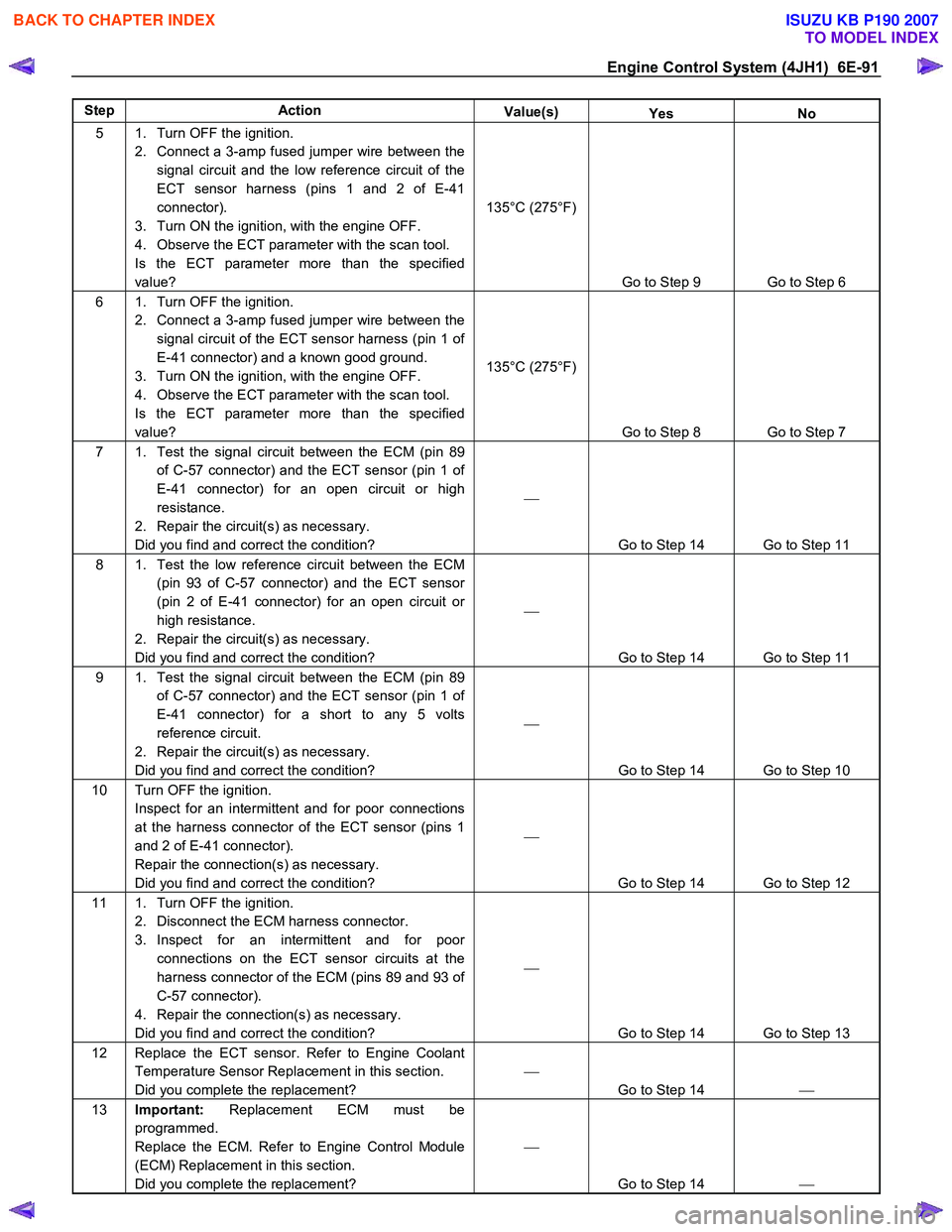
Engine Control System (4JH1) 6E-91
Step Action Value(s) Yes No
5 1. Turn OFF the ignition.
2. Connect a 3-amp fused jumper wire between the signal circuit and the low reference circuit of the
ECT sensor harness (pins 1 and 2 of E-41
connector).
3. Turn ON the ignition, with the engine OFF.
4. Observe the ECT parameter with the scan tool.
Is the ECT parameter more than the specified
value? 135°C (275°F)
Go to Step 9 Go to Step 6
6 1. Turn OFF the ignition. 2. Connect a 3-amp fused jumper wire between the signal circuit of the ECT sensor harness (pin 1 of
E-41 connector) and a known good ground.
3. Turn ON the ignition, with the engine OFF.
4. Observe the ECT parameter with the scan tool.
Is the ECT parameter more than the specified
value? 135°C (275°F)
Go to Step 8 Go to Step 7
7 1. Test the signal circuit between the ECM (pin 89 of C-57 connector) and the ECT sensor (pin 1 of
E-41 connector) for an open circuit or high
resistance.
2. Repair the circuit(s) as necessary.
Did you find and correct the condition?
Go to Step 14 Go to Step 11
8 1. Test the low reference circuit between the ECM (pin 93 of C-57 connector) and the ECT sensor
(pin 2 of E-41 connector) for an open circuit or
high resistance.
2. Repair the circuit(s) as necessary.
Did you find and correct the condition?
Go to Step 14 Go to Step 11
9 1. Test the signal circuit between the ECM (pin 89 of C-57 connector) and the ECT sensor (pin 1 of
E-41 connector) for a short to any 5 volts
reference circuit.
2. Repair the circuit(s) as necessary.
Did you find and correct the condition?
Go to Step 14 Go to Step 10
10 Turn OFF the ignition. Inspect for an intermittent and for poor connections
at the harness connector of the ECT sensor (pins 1
and 2 of E-41 connector).
Repair the connection(s) as necessary.
Did you find and correct the condition?
Go to Step 14 Go to Step 12
11 1. Turn OFF the ignition. 2. Disconnect the ECM harness connector.
3. Inspect for an intermittent and for poor connections on the ECT sensor circuits at the
harness connector of the ECM (pins 89 and 93 of
C-57 connector).
4. Repair the connection(s) as necessary.
Did you find and correct the condition?
Go to Step 14 Go to Step 13
12 Replace the ECT sensor. Refer to Engine Coolant Temperature Sensor Replacement in this section.
Did you complete the replacement?
Go to Step 14
13 Important: Replacement ECM must be
programmed.
Replace the ECM. Refer to Engine Control Module
(ECM) Replacement in this section.
Did you complete the replacement?
Go to Step 14
BACK TO CHAPTER INDEX
TO MODEL INDEX
ISUZU KB P190 2007
Page 1145 of 6020
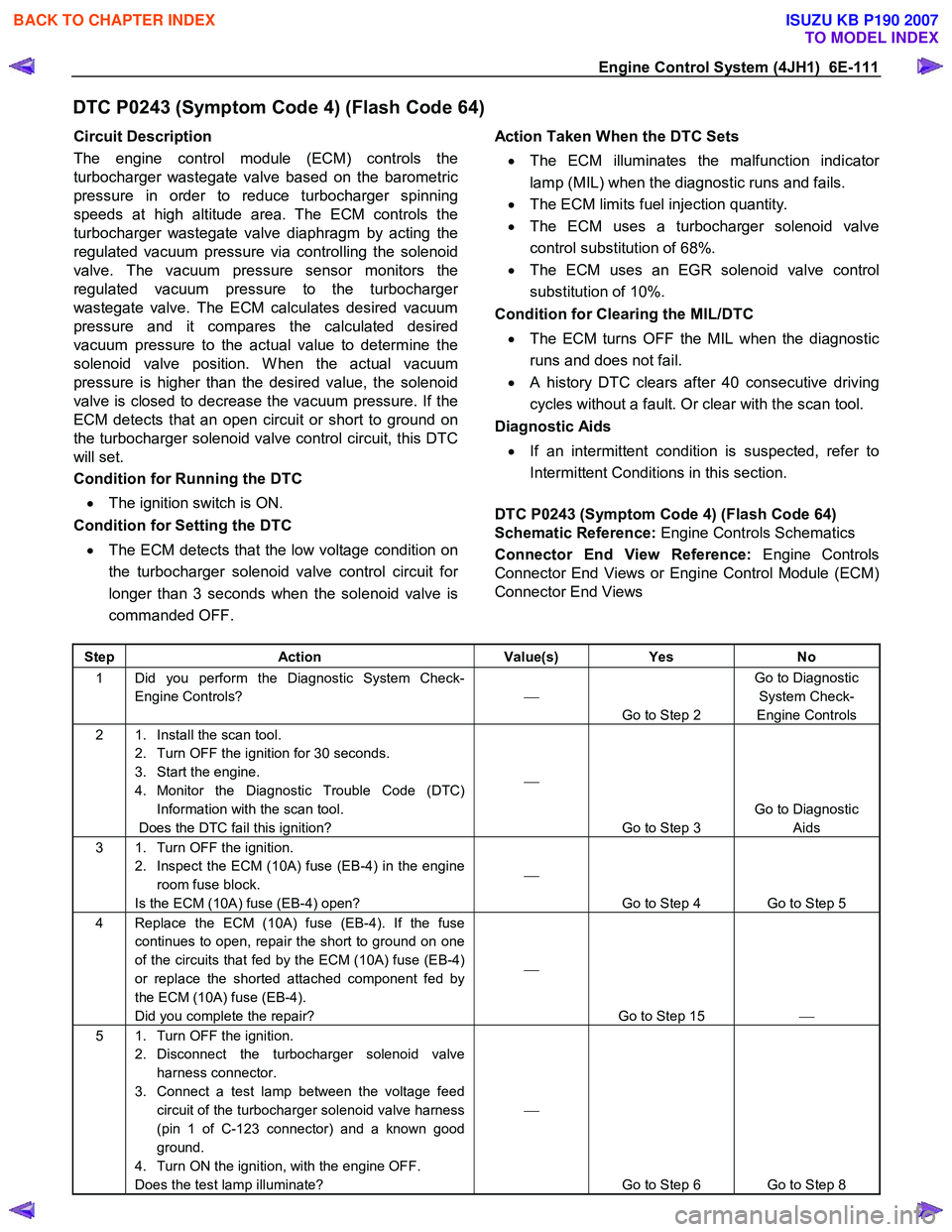
Engine Control System (4JH1) 6E-111
DTC P0243 (Symptom Code 4) (Flash Code 64)
Circuit Description
The engine control module (ECM) controls the
turbocharger wastegate valve based on the barometric
pressure in order to reduce turbocharger spinning
speeds at high altitude area. The ECM controls the
turbocharger wastegate valve diaphragm by acting the
regulated vacuum pressure via controlling the solenoid
valve. The vacuum pressure sensor monitors the
regulated vacuum pressure to the turbocharge
r
wastegate valve. The ECM calculates desired vacuum
pressure and it compares the calculated desired
vacuum pressure to the actual value to determine the
solenoid valve position. W hen the actual vacuum
pressure is higher than the desired value, the solenoid
valve is closed to decrease the vacuum pressure. If the
ECM detects that an open circuit or short to ground on
the turbocharger solenoid valve control circuit, this DTC
will set.
Condition for Running the DTC
• The ignition switch is ON.
Condition for Setting the DTC
• The ECM detects that the low voltage condition on
the turbocharger solenoid valve control circuit fo
r
longer than 3 seconds when the solenoid valve is
commanded OFF.
Action Taken When the DTC Sets
• The ECM illuminates the malfunction indicato
r
lamp (MIL) when the diagnostic runs and fails.
• The ECM limits fuel injection quantity.
• The ECM uses a turbocharger solenoid valve
control substitution of 68%.
• The ECM uses an EGR solenoid valve control
substitution of 10%.
Condition for Clearing the MIL/DTC
• The ECM turns OFF the MIL when the diagnostic
runs and does not fail.
• A history DTC clears after 40 consecutive driving
cycles without a fault. Or clear with the scan tool.
Diagnostic Aids
• If an intermittent condition is suspected, refer to
Intermittent Conditions in this section.
DTC P0243 (Symptom Code 4) (Flash Code 64)
Schematic Reference: Engine Controls Schematics
Connector End View Reference: Engine Controls
Connector End Views or Engine Control Module (ECM)
Connector End Views
Step Action Value(s) Yes No
1 Did you perform the Diagnostic System Check-
Engine Controls?
Go to Step 2 Go to Diagnostic
System Check-
Engine Controls
2 1. Install the scan tool. 2. Turn OFF the ignition for 30 seconds.
3. Start the engine.
4. Monitor the Diagnostic Trouble Code (DTC) Information with the scan tool.
Does the DTC fail this ignition?
Go to Step 3 Go to Diagnostic
Aids
3 1. Turn OFF the ignition. 2. Inspect the ECM (10A) fuse (EB-4) in the engine room fuse block.
Is the ECM (10A) fuse (EB-4) open?
Go to Step 4 Go to Step 5
4 Replace the ECM (10A) fuse (EB-4). If the fuse continues to open, repair the short to ground on one
of the circuits that fed by the ECM (10A) fuse (EB-4)
or replace the shorted attached component fed by
the ECM (10A) fuse (EB-4).
Did you complete the repair?
Go to Step 15
5 1. Turn OFF the ignition.
2. Disconnect the turbocharger solenoid valve harness connector.
3. Connect a test lamp between the voltage feed circuit of the turbocharger solenoid valve harness
(pin 1 of C-123 connector) and a known good
ground.
4. Turn ON the ignition, with the engine OFF.
Does the test lamp illuminate?
Go to Step 6 Go to Step 8
BACK TO CHAPTER INDEX
TO MODEL INDEX
ISUZU KB P190 2007